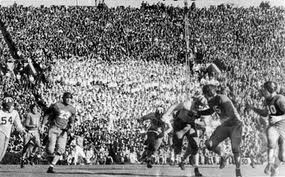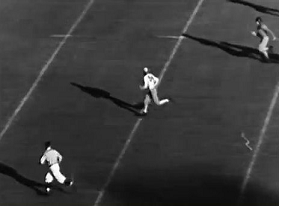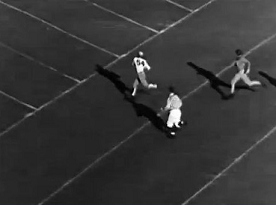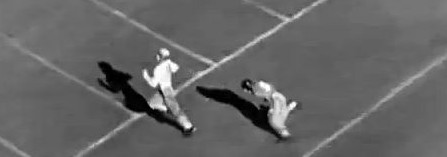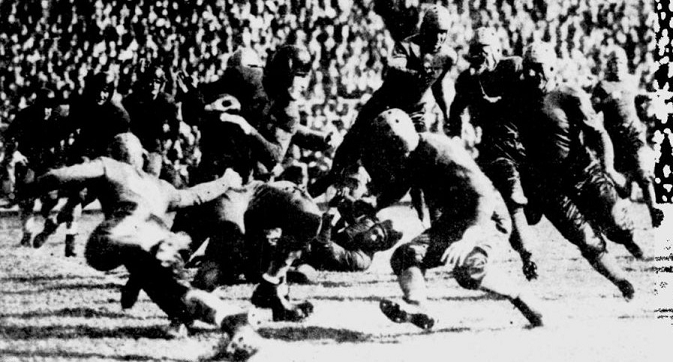
Pictured above is Minnesota's consensus All American halfback, Pug Lund, carrying the ball in 1934's game of the year, in which 8-0 Minnesota scored a pair of 4th quarter touchdowns to beat 8-1 Pittsburgh 13-7. Minnesota and Pittsburgh both stomped on all the rest of their opponents, and at season's end most writers were not only declaring Minnesota the mythical national champion (MNC) of 1934, but one of the greatest teams of all time.

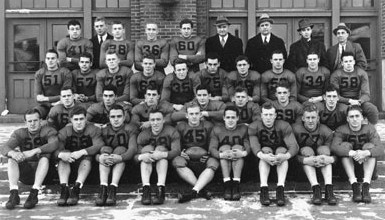
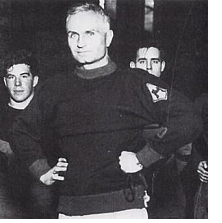 Minnesota
had 2 extended periods of greatness in their football history. The
first was 20 years long, 1900-1919, under Hall of Fame coach Dr. Henry
Williams. They went 132-23-11 over those 20 years, and if there had
been an AP poll during that time, they would have been ranked in a top
25 all 20 years, and top 10 about 14 times. They contended for MNCs in 1903 and 1904, and I selected them as MNC of 1911.
That period was followed by a downturn 1920-1931, when they went
53-33-8. They would have been ranked in a top 25 half of those 12
years, and top 10 just twice. Not bad, but no longer top-shelf
Minnesota
had 2 extended periods of greatness in their football history. The
first was 20 years long, 1900-1919, under Hall of Fame coach Dr. Henry
Williams. They went 132-23-11 over those 20 years, and if there had
been an AP poll during that time, they would have been ranked in a top
25 all 20 years, and top 10 about 14 times. They contended for MNCs in 1903 and 1904, and I selected them as MNC of 1911.
That period was followed by a downturn 1920-1931, when they went
53-33-8. They would have been ranked in a top 25 half of those 12
years, and top 10 just twice. Not bad, but no longer top-shelf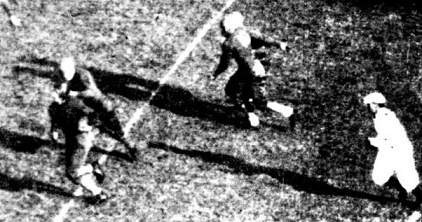
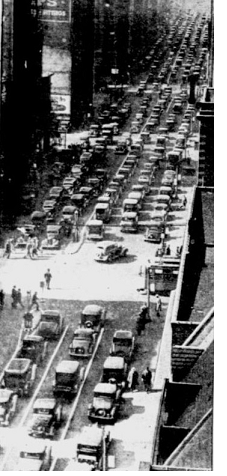 Minnesota essentially played a 1-game season this year, but that one
game was huge, at MNC caliber Pittsburgh. Pitt had been regularly
contending for MNCs since 1925, and the school claims national titles
for 1929 and 1931, though I don't recognize either of those (they lost
47-14 to Southern Cal in the Rose Bowl following the 1929 season).
Parke Davis had selected them for those seasons. But curiously, Pitt
also claims an MNC for 1934, even though they lost to 8-0 Minnesota,
and no organization listed in the NCAA Records Book, human or computer,
selected them for this season. Their media guide lists Parke Davis as
the selector who chose them for 1934, but he died in June of 1934,
before the season had even started. Whoops. That's a fine institution
of higher learning they've got there.
Minnesota essentially played a 1-game season this year, but that one
game was huge, at MNC caliber Pittsburgh. Pitt had been regularly
contending for MNCs since 1925, and the school claims national titles
for 1929 and 1931, though I don't recognize either of those (they lost
47-14 to Southern Cal in the Rose Bowl following the 1929 season).
Parke Davis had selected them for those seasons. But curiously, Pitt
also claims an MNC for 1934, even though they lost to 8-0 Minnesota,
and no organization listed in the NCAA Records Book, human or computer,
selected them for this season. Their media guide lists Parke Davis as
the selector who chose them for 1934, but he died in June of 1934,
before the season had even started. Whoops. That's a fine institution
of higher learning they've got there.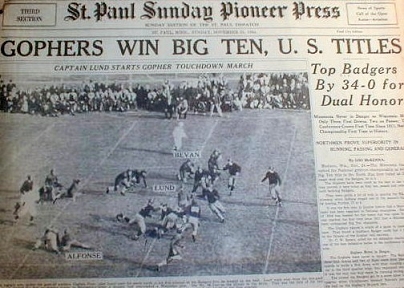
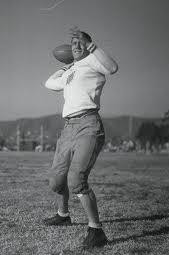
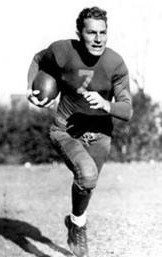
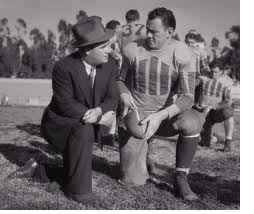 Alabama had previously won consensus national championships in 1925, 1926, and 1930, though
I do not recognize them as a 1926 MNC. They were not a consensus choice
for this season, and in fact were not selected by any human in the NCAA
Records Book, but the school claims another MNC for 1934. All four
seasons have one thing in common
Alabama had previously won consensus national championships in 1925, 1926, and 1930, though
I do not recognize them as a 1926 MNC. They were not a consensus choice
for this season, and in fact were not selected by any human in the NCAA
Records Book, but the school claims another MNC for 1934. All four
seasons have one thing in common